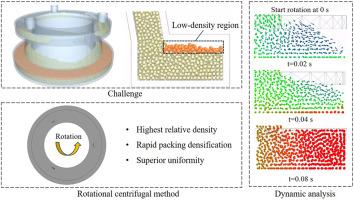Discrete element analysis of rotational centrifugal method for enhanced powder packing densification in a pre-HIP capsule
IF 4.3
2区 材料科学
Q2 ENGINEERING, CHEMICAL
引用次数: 0
Abstract
Hot isostatic pressing (HIP) is a critical powder metallurgy technique for manufacturing high-performance components. However, achieving uniform powder distribution within complex capsules is challenging, particularly in critical low-density regions where inadequate powder filling leads to non-uniform deformation and potential part rejection after HIP. This study investigated the powder filling and packing densification behavior of Ti-6Al-4V particles through discrete element method (DEM) simulations to develop an enhanced densification technique targeting these critical regions. A new rotational centrifugal method was proposed to address this challenge. Results demonstrated that vertical vibration achieved limited improvement, and horizontal vibration exhibited non-uniform powder distribution. The proposed rotational centrifugal method at 200 rpm proved most effective, achieving the highest relative density with superior uniformity and rapid densification. The analysis in rotational motion revealed that rapid densification originates from consistent centrifugal forces. Upon stopping rotation, particles undergo localized vigorous motion, resulting in a slight decrease in relative density. To address this, an optimized deceleration scheme was developed. It achieved a relative density of 0.549, representing improvements of 70.5 % over vertical vibration and 4.2 % over horizontal vibration. These findings provide valuable insights for optimizing pre-HIP processing parameters for complex components, offering a promising solution for addressing powder filling challenges.

旋转离心法在预hip胶囊中增强粉末包装致密化的离散元分析
热等静压(HIP)是制造高性能零件的一项关键粉末冶金技术。然而,在复杂的胶囊内实现均匀的粉末分布是具有挑战性的,特别是在关键的低密度区域,在那里,粉末填充不足会导致不均匀变形和髋关节置换术后潜在的零件报废。本研究通过离散元法(DEM)模拟研究了Ti-6Al-4V颗粒的粉末填充和堆积致密化行为,以开发针对这些关键区域的强化致密化技术。为了解决这一问题,提出了一种新的旋转离心方法。结果表明,垂直振动对粉末的改善有限,水平振动对粉末的分布不均匀。所提出的旋转离心方法在200 rpm被证明是最有效的,实现最高的相对密度与优越的均匀性和快速致密化。旋转运动的分析表明,快速致密化源于持续的离心力。在停止旋转后,粒子进行局部剧烈运动,导致相对密度略有下降。为了解决这一问题,开发了一种优化的减速方案。相对密度为0.549,比垂直振动提高了70.5%,比水平振动提高了4.2%。这些发现为优化复杂部件的预hip加工参数提供了有价值的见解,为解决粉末填充挑战提供了有前途的解决方案。
本文章由计算机程序翻译,如有差异,请以英文原文为准。
求助全文
约1分钟内获得全文
求助全文
来源期刊

Particuology
工程技术-材料科学:综合
CiteScore
6.70
自引率
2.90%
发文量
1730
审稿时长
32 days
期刊介绍:
The word ‘particuology’ was coined to parallel the discipline for the science and technology of particles.
Particuology is an interdisciplinary journal that publishes frontier research articles and critical reviews on the discovery, formulation and engineering of particulate materials, processes and systems. It especially welcomes contributions utilising advanced theoretical, modelling and measurement methods to enable the discovery and creation of new particulate materials, and the manufacturing of functional particulate-based products, such as sensors.
Papers are handled by Thematic Editors who oversee contributions from specific subject fields. These fields are classified into: Particle Synthesis and Modification; Particle Characterization and Measurement; Granular Systems and Bulk Solids Technology; Fluidization and Particle-Fluid Systems; Aerosols; and Applications of Particle Technology.
Key topics concerning the creation and processing of particulates include:
-Modelling and simulation of particle formation, collective behaviour of particles and systems for particle production over a broad spectrum of length scales
-Mining of experimental data for particle synthesis and surface properties to facilitate the creation of new materials and processes
-Particle design and preparation including controlled response and sensing functionalities in formation, delivery systems and biological systems, etc.
-Experimental and computational methods for visualization and analysis of particulate system.
These topics are broadly relevant to the production of materials, pharmaceuticals and food, and to the conversion of energy resources to fuels and protection of the environment.
 求助内容:
求助内容: 应助结果提醒方式:
应助结果提醒方式:


